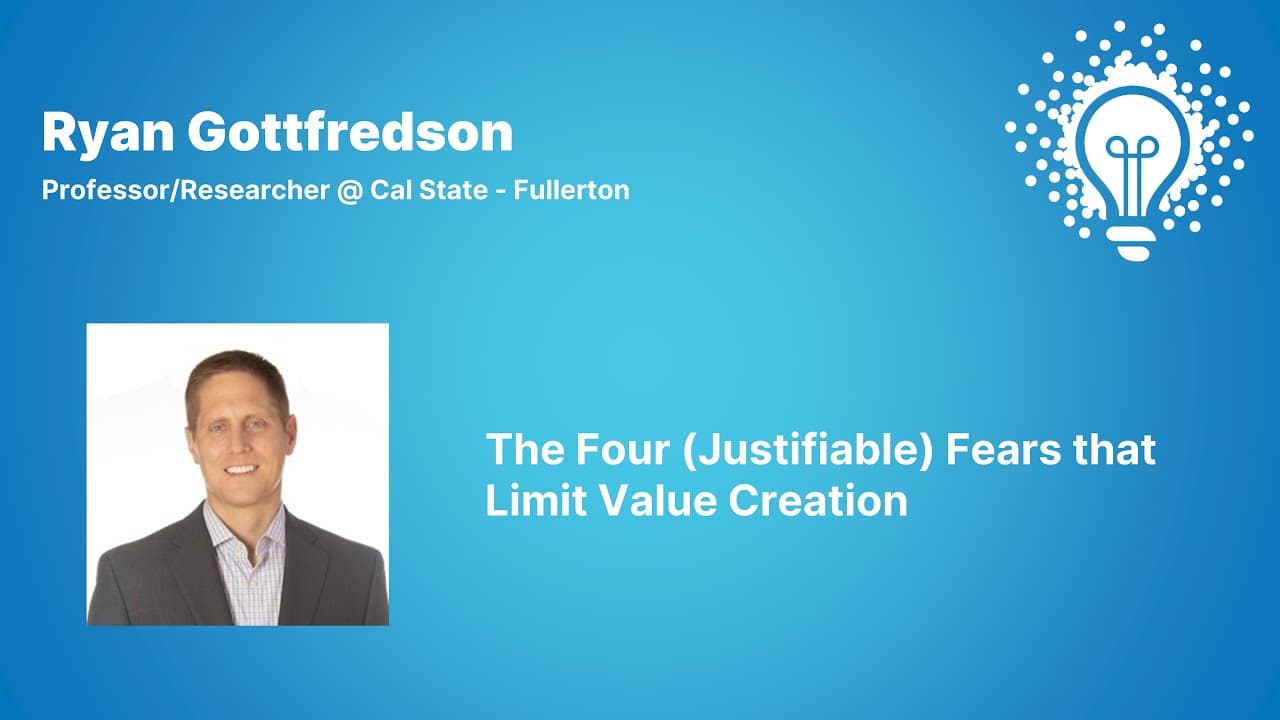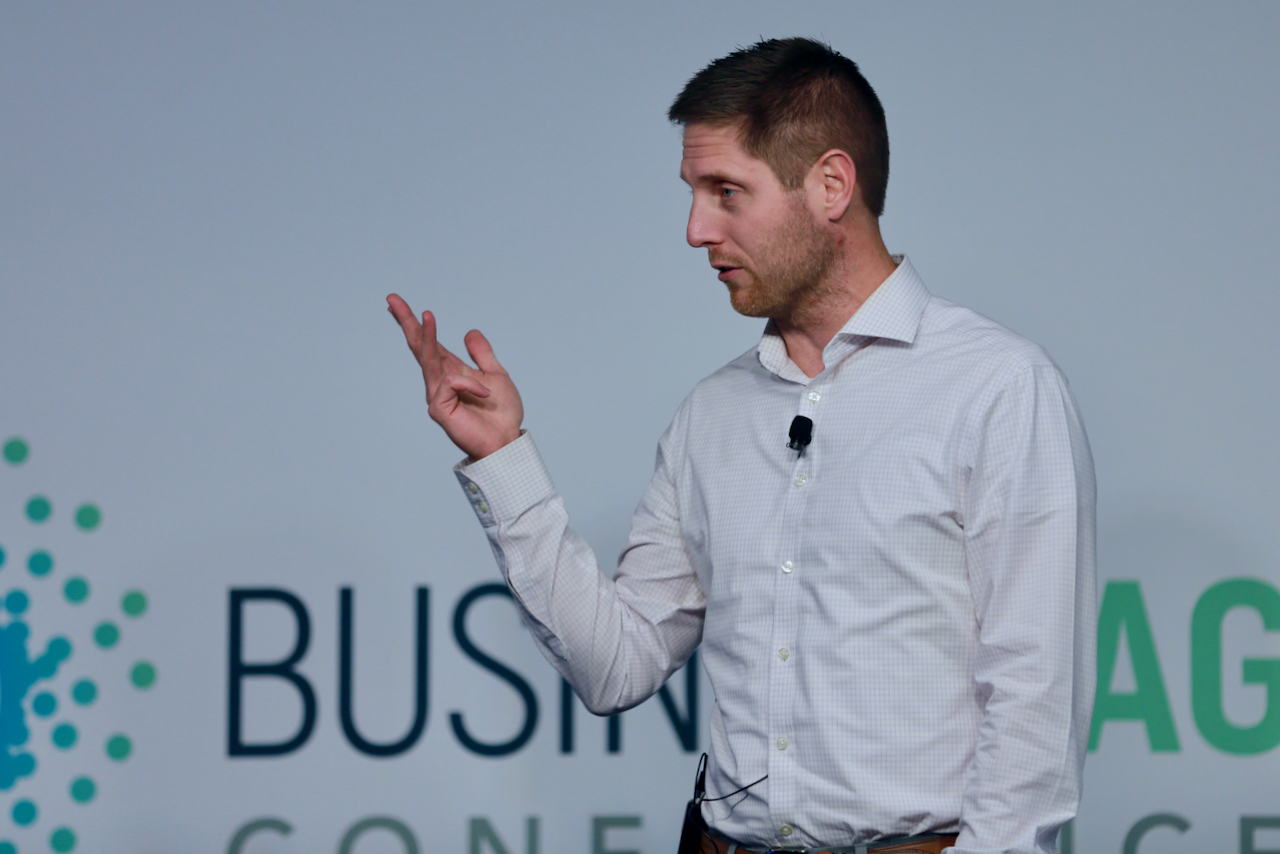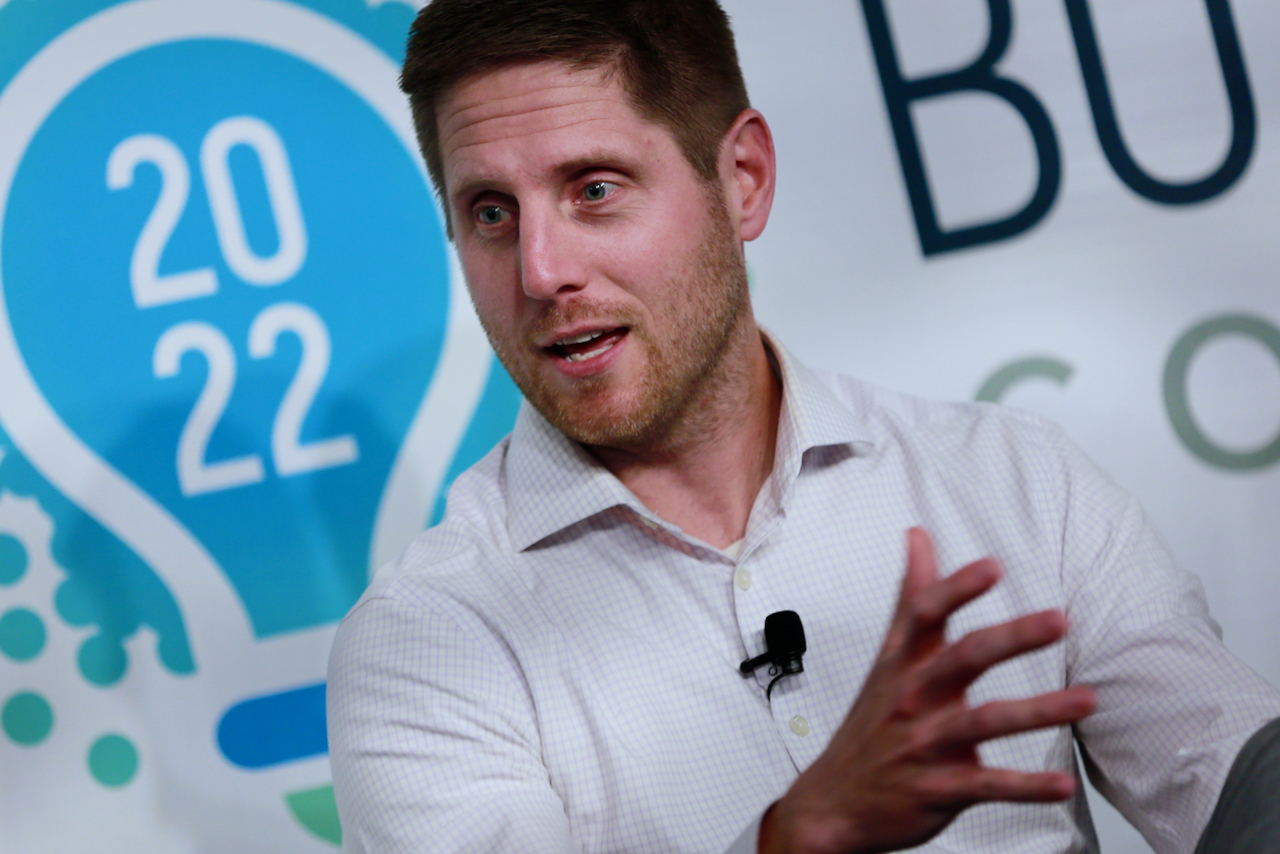It's great to be with all of you. One of the things that I do as I go around, I work with organizations, is I'm an observer. One of the things that I've observed is that organizations either emphasize making progress or creating value. And one of the things that I've also observed, and this is my personal belief, is that more organizations focus on making progress than they do on creating value. Let me give you a few extreme examples of this. You could think about Wells Fargo, or Volkswagen, or Theranos who, it seems like the only reason why they would have engaged in their fraudulent practices, is if they were more focused on making progress than on creating value. Now what I've also observed is that when organizations focus on making progress, this actually hinders agility and long term growth. But, when organizations focus on creating value, this enables agility and long term growth. And so what I want to do with my time here with you is I want to answer the question, "why do organizations commonly get sucked into focusing on making progress?" And "how can we break free from its justifiable and enticing grip?".
So to make this come to life for you a little bit, I want to use a metaphor of a hot air balloon. If we imagine that an organization is the hot air balloon and the passengers in it are the organizations stakeholders. So these are the organization's customers, employees, shareholders, and community partners. And one of the things we want to recognize about this hot air balloon here is that it is off the ground. So this organization is currently functioning, which is great. And how this organization gets to its destination is it could do so in a couple of different ways.
One, it can make progress. It can move horizontally and if you imagine that you're a passenger, how many of you have been in a hot air balloon? I haven't been in a hot air balloon, but I imagine if I had and if somebody just put me in a hot air balloon and we just moved horizontally, I'm not sure I would be very excited about that trip. I would be a little bit more excited if we went up. This is about creating value here. But what we also need to recognize here, going off of this image, is that there are four ropes, or tethers, that are commonly exist that prevent organizations from going up in terms of creating value. And these four ropes are justifiable fears that limit value creation. I mean, just imagine if you're a leader or a manager, which many of you probably are. It can be scary to let the balloon go. Because if that balloon goes up, there's a lot of bad things that could potentially happen.
So it's very justifiable to keep holding on to these ropes. But I want to give you labels for each of these ropes. And to do so, I want to share with a little bit about my personal kind of professional experience. So I finished my doctorate degree at Indiana University, and I took a job at Cal State Fullerton. Has anybody heard of Cal State Fullerton? I had never heard of Cal State Fullerton before I applied. But we're actually the second largest business school in the country, which is a great thing to be a part of. But for two years I was at Cal State Fullerton, and I was feeling stuck. I don't know. I think I was in a rut and an opportunity came to join a consulting firm that I really looked up to. And I considered them to be cutting edge. And so I took a one year leave of absence from the University and joined this consulting firm, thinking that this was going to be my career. That I was leaving academia, and I was going to join this consulting firm. And so I got into this organization really excited because again, I thought it would be cutting edge. And I found out that it was not cutting edge. It had all four of the fears that I'm going to discuss. So let me bring these fears to life.
To understand this first fear, what you need if you can go back in time to 2004, organizations were blowing up their performance management systems. And so this consulting firm wanted to provide value to its customers, and it decided to create some material in which they could sell and help customers. When I came around in 2006, they asked me to review this material. And I'll be honest with you, it is the best performance management material that I have ever come across. But here's the thing. They didn't release their material for another two years. In 2008, they were about four years too late, right? And I asked people in the organization, "Why did you wait so long?". And they said to me, we needed to make sure it was perfect before we released it. Right? So what's going on here is a fear of looking bad. And this fear is incredibly justifiable because if we look bad in the marketplace, we will lose respect. That makes sense, right? But what we've got to understand is if we are unwilling to look bad, we will rarely try something new and we won't get out of our comfort zones. So in this instance, this consulting company was making progress, but I don't think it was creating value. For fear number two, we're going to fast forward a few months. I got invited to work on a project. This was a customer engagement project, and I was going to be the data analyst. So the data had already been collected, and my job was to sift through this data and identify data driven recommendations to help this organization better understand how it can gain its customers. But as I got my hands on this data, I realized that early in the project, the project manager had made a decision to collect the data through two different methodologies. They would send out emails to customers, and they would have other customers respond to surveys in their stores. And what I found, as I looked at this data, is that effectively, when I looked at the data driven recommendations, if we looked at the data from in the stores, we got recommendations A, B, and C. If we looked at the data from the emails, it was X, Y, and Z. And I found this a little bit problematic.
Thinking, what are we going to present to the customer? So I went to the project manager and just explained the situation. And I was a little surprised that the project manager got really defensive. And he kind of just shot back, no, merge the two data sets and let's come up with whatever that data represents, which was effectively M, N, and O. And I look back on the situation, I wonder, why did he get so defensive? And I think he realized that he had made a mistake by employing multiple methodologies and because he was unwilling to admit that, he got a little bit defensive. But this is justifiable. This fear of being wrong. Because if we're wrong, that may mean that we aren't providing value. But if we are unwilling to be wrong, we will care more about being right than finding truth and thinking optimally. Here's another instance where, yes, we made progress, but I'm not so sure how much value we created for that customer. For the third fear, I learned this fear right away. Almost on my first day. I had people tell me, if you're ever going to present a slide deck to a client, that slide deck needs to be proof read by our Editors. There's three of them, and we needed to give them at least three days of lead time, if not a week. I was, wow, this seems a little excessive. And so I asked why? And they said, well, if we have some data wrong on our slides, the client will question everything else that we say. Which may be true. Right. But implicit in this is a fear of having problems. And this is justifiable.
We don't like to have problems because that means we need to clean up. How many of you are parents? I've got a ten year old and a seven year old, and I know this very well. I don't like cleaning up after my kids. Right. But, while this is justifiable, if we are unwilling to have problems, we will be slow, we will only do the things that we believe that we will be successful at, and we will never push the envelope. So here's an instance where, again, I think we made progress, but I think we were really slow in creating value. For this fourth fear, I want to tell you just a little bit about, I think one of my most favorite research studies that's ever been done. This research study looked at the size of the image of the CEO in the company's annual report and their subsequent firm performance. Have you heard of the study before? What they found, and maybe not surprisingly, is the larger the photo of the CEO, the worse their subsequent firm performance. Does that surprise you?
The reason why I say this is when I victim the CEO of this consulting company. He liked a rather large image of himself, if you know what I mean. And I think that this trickled down in the organization. And how this played out for me is that what I observed is the project managers always felt like they needed to be the one presenting to the client. And as somebody who likes to present, and generally knew the data better than anybody else, I was rarely given the opportunities to present. And the way that I now see this is I think there was a fear of not being seen. You see, the project manager probably had this fear. If I'm not in front of the client presenting, then they may perceive that I'm not adding much value to them. Right. And so that is justifiable. But again, if we need to be seen, we will create conditions where both customers and employees get less. Again, we can say here we're making progress, but I'm not sure we're adding as much value as we could. So these are the four fears that leaders and managers commonly hold onto that are justifiable. Right. Fear of looking bad, being wrong, having problems, and not being seen of value. And this makes sense because who likes to look back, who likes to have problems or who likes to be wrong, who likes to have problems, and who likes to not be seen?
Nobody. Right. So these make complete sense. But the very things that prevented this organization from being cutting edge. And now when I look at this organization, in the marketplace, is it's being blown out by its competitors. It used to be at the top of the food chain, and now it's falling way behind. I want to get maybe even a little bit more personal, to share with you a little bit about how I discovered these different fears. So I was with this consulting company for about eleven months. And as you can tell, there was a little bit of struggles that I was working through. And at one point in time, I'm talking to my manager on the phone, kind of complaining about something that was going on. And my manager stops the conversation. She says, "Look, I don't think that this position is a good fit for you." "We're going to let you go."
I hope none of you are in this situation. But my heart dropped. I never thought I would be somebody that would be laid off. And there I was being laid off. And as heartbreaking as that was for me, at the time, often times in situations like this, it's kind of a blessing in disguise. In this particular situation, I got laid off in June. I decided to go back to the University at Cal State Fullerton. And from June until the end of August, when our semester started, I got to dive into my research on the mindsets and fears that prevent agility and prevent growth. And what I discovered for myself is that I had all four of these fears myself. So I had the fear of looking bad.
Let me give you an example. My freshman year of college, I wanted to become a medical doctor. So I signed up for the weeder premed chemistry class. And at the end of the semester, I got the worst grade I had ever received. It was a C. And to me, I was looking bad. And when I thought about my future taking more chemistry classes, I just thought it was more looking bad. And so what I decided to do was I gave up on my major. I gave up on my dream of becoming a medical doctor. I changed my major. Instead of understanding that probably my study habits as a freshman in college weren't too good. All right. I also saw that I had a fear of being wrong. In one of my college classes, we were reviewing one of our exams, and students stood up and started to argue how one of the questions on the exam was a terrible question. Being a little caught off guard by this, I got defensive, and I effectively put this student in his place. And I lost the class for the rest of the semester. I also had a fear of having problems. I never wanted to be an entrepreneur. Because being an entrepreneur, to me, was just a string of problems. And I also had a fear of not being seen. I think this came about at a pretty young age. So I played a lot of basketball growing up. And when I played basketball, if I'm being honest with you, I cared more about being the top scorer on our team than about winning the game. Because if I wasn't the top scorer, I wasn't being seen.
So for me, this was a very rude awakening, and I had to wrestle with these fears. But as I awaken to these fears and I work through them, I believe I've shifted from being somebody who makes progress to somebody who creates value. I wrote my book, Success Mindsets, which hit The Wall Street Journal and USA Today bestseller list. I became an entrepreneur or else I wouldn't be standing here today. And I believe I am more emotionally intelligent such that I'm a better teammate and I'm okay admitting when I'm wrong. Although I still think I've got some work to do. So these are the four fears. I think we all have them because they're self protective. Right. And if we want to get over them, we need to understand that there are two different forms of development. One form of development is called horizontal development. This is a typical form of development that we talk about. But there's another form of development that we don't talk a lot about, and that's vertical development. Let me define these for you. Horizontal development is adding more knowledge, skills, and competencies to what we have. The focus of horizontal development is on doing more. We're adding an app onto an iPad. What that new app does is it broadens that iPad's functionality. This is good, but it has a severe limitation. It doesn't allow the iPad to navigate their world more effectively or do more complex things, operate more quickly, or be any more agile. If we want those things, we need vertical development. Vertical development is elevating our ability to make meaning of our world in more cognitively and emotionally sophisticated ways. The focus here isn't on doing more, it's on being better. We're not adding an app onto the iPad. We're upgrading our own internal operating system. And what this implies is people with low vertical development have fears of looking bad, being wrong, having problems, and getting passed up. People with high vertical development, they're focused on learning and growing, finding truth, reaching goals, and lifting others.
And what's really tricky about this is that if we want to learn and grow, we've got to be okay looking bad at times. If we want to find truth, we've got to be okay being wrong at times. If we want to reach our goals, we've got to be okay having problems at times. And if we want to lift others, we've got to put ourselves on the back burner at times. And I don't know about you, but it's just not easy to do those things at times. Right. What we actually need to do is we need to broaden or widen our window of tolerance for looking bad, being wrong, having problems, and getting passed up. And so how do we go about cutting our ropes? First, we need to awaken to our fears. We need to understand what they are.
I'll invite you to take your phone out and you can take a picture of this QR code. It will direct you to a mindset assessment that I've developed. You can assess your mindset across four different sets of mindsets. And this will help you awaken to what self protective fears you might have. I'll go back for a second. If you have a fixed mindset that will reveal that you probably have some fears around looking bad. If you have a closed mindset, you probably have some fears around being wrong.
If you have a prevention mindset, you probably have some fears around avoiding problems. And if you have an inward mindset, you probably have some fears around getting passed up. The second thing that we need to do, and you've heard this word a lot already, is we need to get clear on our purpose. And it needs to be a purpose that is focused on creating value, not on making progress.
In fact, our why needs to be stronger than our fears of looking bad, being wrong, having problems, and getting passed up. In fact, we've got to be okay with those things in order to get to our why or fulfill our purpose. So, I got a challenge for you. One is I want you to set an intention. What rope are you going to cut? And what can you do in the next week to work towards cutting it?
Because at the end of the day, my challenge for you is to cut your fears, so that you can be a greater value creator and less of just a progress maker.






